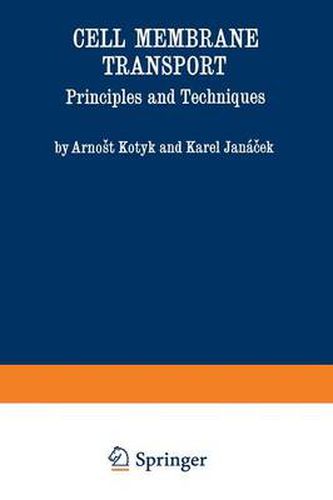Readings Newsletter
Become a Readings Member to make your shopping experience even easier.
Sign in or sign up for free!
You’re not far away from qualifying for FREE standard shipping within Australia
You’ve qualified for FREE standard shipping within Australia
The cart is loading…






This title is printed to order. This book may have been self-published. If so, we cannot guarantee the quality of the content. In the main most books will have gone through the editing process however some may not. We therefore suggest that you be aware of this before ordering this book. If in doubt check either the author or publisher’s details as we are unable to accept any returns unless they are faulty. Please contact us if you have any questions.
It is not a particularly rewarding task to engage in writing a book on a subject which is undergoing a rapid and potentially revolutionary develop ment, but, on the other hand, the investigation of transport of substances into and out of cells has reached a stage of maturity or at least of self realization and this fact alone warrants a closer examination of the subject. No one will doubt at present that the movement-mostly by selective translocation-of substances, ranging from hydrogen ions to deoxyribo nucleic acids, across the cell-surrounding barriers represents one of the salient features of a living cell and that, if we are permitted to go so far, the cessation of the selective transport processes might be considered as the equivalent of cell death. Hardly anybody will question the premise that cell and tissue differentiation within the ontogenetic development of an organism is closely associated with properties of the outer cell face. Perhaps no serious scholar will attempt to refute the concept that mem branes with characteristic morphology and composition represent the ar chitectural framework for the whole cell. And probably no experienced biologist will raise objections to the belief that many physiological processes, like nervous impulse conduction and other electrical phenomena of cells and tissues or their volume changes, are associated with membrane-regulated shifts of ions and molecules.
$9.00 standard shipping within Australia
FREE standard shipping within Australia for orders over $100.00
Express & International shipping calculated at checkout
This title is printed to order. This book may have been self-published. If so, we cannot guarantee the quality of the content. In the main most books will have gone through the editing process however some may not. We therefore suggest that you be aware of this before ordering this book. If in doubt check either the author or publisher’s details as we are unable to accept any returns unless they are faulty. Please contact us if you have any questions.
It is not a particularly rewarding task to engage in writing a book on a subject which is undergoing a rapid and potentially revolutionary develop ment, but, on the other hand, the investigation of transport of substances into and out of cells has reached a stage of maturity or at least of self realization and this fact alone warrants a closer examination of the subject. No one will doubt at present that the movement-mostly by selective translocation-of substances, ranging from hydrogen ions to deoxyribo nucleic acids, across the cell-surrounding barriers represents one of the salient features of a living cell and that, if we are permitted to go so far, the cessation of the selective transport processes might be considered as the equivalent of cell death. Hardly anybody will question the premise that cell and tissue differentiation within the ontogenetic development of an organism is closely associated with properties of the outer cell face. Perhaps no serious scholar will attempt to refute the concept that mem branes with characteristic morphology and composition represent the ar chitectural framework for the whole cell. And probably no experienced biologist will raise objections to the belief that many physiological processes, like nervous impulse conduction and other electrical phenomena of cells and tissues or their volume changes, are associated with membrane-regulated shifts of ions and molecules.